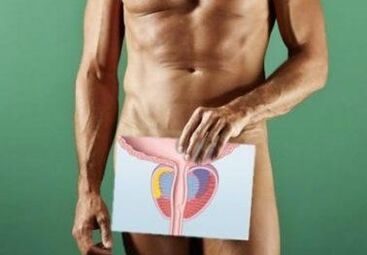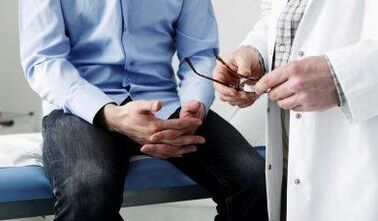Inflammation of the prostate gland is a serious disease that can cause serious consequences if it is not treated.The prostate is located under the bladder.
When it is inflamed, it increases significantly, blocking the bladder neck and disrupting the flow of urine.Therefore, with the first symptoms and manifestations, it is necessary to contact the specialist immediately to identify and begin the treatment of prostatitis.

The main symptom: How is prostatitis indicated?
Previously it was believed that these are adults and elderly diseases, but in modern life (ecological, food quality, fashion, youthful attitude towards their health, continuous movement with cars, etc.), inflammation of the prostate gland is "younger".
The incidence of young people under the age of 18 is 5%, ages 18 to 30 - 45%, from 30 to 50 years - 20%, over 50 years - 30%.This shows that it is necessary to follow your men's health and hear symptoms from a young age.
There are several types of prostatitis in the form of manifestations (chronic, acute) and by type of inflammation (bacteria, stagnants, purulent, contagious, maternity).Symptoms of the disease can vary, depending on the type of inflammation of the prostate gland in men.
Symptoms of acute prostatitis:
- Poor poor (weakness, chills, fever).One can start throwing away either in hot or cold conditions.General symptoms resemble manifestations of SARS or influenza;
- significant increase in body temperature to subfubbrille (37.5-38 degrees) and higher;
- severe cuts, stitch pain in the perineum (thighs, anal, etc.);
- back pain, hips, gives feet, knees, legs or leg muscles;
- acute pain that occurs during water and tense action;
- Problems with urination (inadequate / frequent urination, painful or difficult to urinate).Urine delay for a long period of time (more than 12 hours);
- deterioration of sexual function (absence of erection, poor or complete ejaculation, problems with conception);
- Release from the genitals (in the worst and most advanced prostatitis cases).
Symptoms of chronic prostatitis:
- urinary problems (difficult urination, pain, insufficient urine, incomplete emptying of the bladder, etc.);
- Unpleasant pain and sensation in the crotch, between the legs, in the thighs, in the anus.Pain syndrome is not spoken;
- In the thighs, sometimes sharp pain or strong burns can occur, turning into crowns;
- general weakness for long periods of time (drowsiness, indifference, depression, persistent fatigue, muscle weakness, etc.);
- anxiety, irritation;
- A slight increase in body temperature.Sometimes the subfebrile temperature can remain for a long time;
- Reduction of sexual function (problem with erection, decrease or lack of ejaculation, decreased libido, infertility, etc. -more).

Chronic courses of prostatitis involve periods such as forgiveness and relapse.During relapse, symptoms of chronic forms can develop into symptoms of acute disease.
Bacterial symptoms:
- signs of inflammation (heat, fever, fever, general weakness, muscle and bone pain syndrome);
- signs of local inflammation of the prostate (pain in the perineum, thighs, anus);
- problematic urine;
- Change the consistency, color and odor of fluid (urine, prostate secret, sperm, blood).
Calculus symptoms:
- Weak and moderate pain syndrome in the lower, sacred parts, throat, anus;
- Pain pain and burns in the perineum, thighs;
- Pain significantly increases after sex and during active movement;
- problems with urination, bladder rupture;
- decreased libido, problems with ejaculation and erection (up to erectile dysfunction);
- In advanced cases, blood droplets may appear in the sperm (it becomes pink or bright red).
Symptoms of unstable form:
- Unpleasant sensations in the thighs, throat and anal;
- Pain that is regularly attractive in the perineum;
- problematic urine, feeling is not completely bladder;
- continuous increase in temperature to subfebrile marks;
- manifestations of general inflammation in the body (increased ESR, malaise, drowsiness, fatigue, headache, weakness, muscle aches, etc.);
- Problems in the genital area (ejaculation and poor erection, infertility);
- Nervous conditions, depression, indifference.
Symptoms of contagious forms:
- signs of inflammation in the body (an increase in the value of an ESR in a man's blood, muscle aches, fever);
- pain in the lower back, thighs and perineum;
- pain during drainage;
- sharp pain in the thighs and perineum;
- Problems with urination (difficult, fast urination, lack of impulse, etc.).
Symptoms of purulent forms:
- a strong increase in body temperature (above 38, 5 degrees);
- signs of inflammation in the body (high value of ESR, muscle aches, heat, chills, etc.);
- Pain syndrome is pronounced on the thighs, perineum and anal;
- sharp pain in the perineum;
- difficult to urinate, painful urine;
- Purulent release from the genitals.
What are the first signs of men?
With the early inflammation of the prostate in a man, only part of the symptoms of the disease can occur.Signs of early inflammation of the prostate, which should pay special attention to:

- unpleasant sensations in the perineum;
- Weak pine with base base and perineum;
- attract unpleasant sensations in the anus and intestines during water removal (without hemorrhoids);
- Long general malaise, not related to SARS, tonsillitis, influenza and other colds;
- decreased libido, damage during ejaculation and erection (periodic absence);
- decrease in quality of orgasm;
- Unpleasant sensations in the urethra and in the thighs during sex or after sex;
- Change of consistency, color and smell of sperm;
- Increase body temperature.
Signs of acute prostatitis:
- increased temperatures to 37.5-40 degrees for no apparent reason (not flu, not flu, not angina);
- The frequency of urine increases by 3-4 times and is accompanied by sharp pain.Urine flow slowly and with poor pressure;
- Burning in the thighs, perineum and during water removal.Intestinal pain during water removal;
- The release of pus from the intestines or urethra (with severe courses and forms of purulent disease).
Signs -Chronic inflammation of the prostate:
- Burning in the thighs and perineum.Burning in the genitals (especially when urinating and sex);
- Purulent release from the urethra after urine and when submerged (active movement or drainage).Purulent release from rectum;
- anxiety, depression, irritation;
- Fast fatigue for no apparent reason, sleepy.
Pain syndrome for inflammation of the prostate gland
Almost always, with inflammation of the prostate gland, a man can learn about the cause of the pain syndrome by his character.Interesting features, pain or acute pain appears in the spine and thighs.In the form of acute or with the relapse of chronic pain, the pain is characterized as acute, sharp, strong, cutting and attractive.In the form of chronic diseases, pain is periodic, such as waves.Also, the pain syndrome can be weak, but fixed.The inflamed prostate gland presses on the urethra, bladder neck and ureter.It is in these channels that urine comes out of the bladder, from which pain can occur during urination.Also, urinary tract pain can be a sign of infection of the bladder system or genitourinary (sexually transmitted disease).
The accompanying pain can cause a completely different occurrence.Just like the presence of some of the pain that accompanies prostatitis may not be at all inflammation of the prostate gland, but with one set of other diseases.
Other causes included:
- Abdominal pain is a symptom of many other diseases.Interesting examples are appendicitis, acute poisoning, intestinal infections or inter -religious.
- The lower back can hurt because of the hernia, osteochondrosis, pinching the nerve endings, osteoporosis, scattered sclerosis and other spinal diseases.
- Pain in the anus can occur due to hemorrhoids, cracks, bruises, long sitting on uncomfortable solid surfaces and various neoplasms (benign or malignant).
- Sacral spinal pain syndrome is more serious.Often this is a problem with bones, vertebrae and disc (osteochondrosis, osteoporosis, displacement, pinch, etc.).

Sometimes pain in the sacrum means problems with other internal organs (kidneys, intestines, bladder and ureter), gynecological disease, thrombophlebitis, pelvic organs.
- Foot pain can mean manifestations of flat feet, thrombophlebitis, atherosclerosis, varicose, arthritis, osteoporosis, sciatic nerve inflammation and even diabetes.Pain in the feet can have many different reasons.
The most common is the fatigue of the feet and muscles of prolonged physical activity.
Which specialist is involved in the treatment of the disease?
In patients, only qualified doctors are diagnosed in patients, a urologist.He collected anamnesis and researched the patient.He then ordered the man for testing (PSA-antigen-protein to detect prostatitis) and pelvic organs ultrasound.
Also, patients without failing to pass the blood and urine tests.Based on the results of all analysis, urologists can accurately determine the diagnosis and form of inflammation of the prostate gland.Only after this procedure can the doctor prescribe individual treatment courses, including medications, antibiotics and other medications that usually take home.
A man in 95% of cases knows exactly what urological diagnosis will make, because the pain with prostate inflammation is very specific.It is necessary to constantly listen to your body, to monitor all the changes that occur with the body.This is the only way a man can maintain the health of men for years.Consolidated prostatitis threatens not only urine disorders, but also with problems with libido, ejaculation, erection, which can eventually cause infertility.













